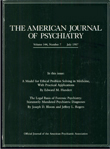Dopamine D2 Receptor Blockade in Schizophrenia
To the Editor: We read with interest the results of a recent study making use of [123I]iodobenzamide single photon emission computed tomography ([123I]IBZM SPECT) with schizophrenic patients (1). The authors demonstrated a significant correlation between striatal dopamine D2 receptor occupancy by olanzapine and risperidone in the presence of depressive symptoms, negative symptoms, and negative subjective experiences as measured by the Subjective Well-Being Under Neuroleptic Treatment Scale.
We attained similar results in a study of 18 schizophrenic patients treated with typical antipsychotics who were scanned with[123I]IBZM SPECT (2). We reanalyzed this data using three items from the Brief Psychiatric Rating Scale (BPRS) that were specific to depression (depressive mood, guilt feelings, and suicidality) as a measure of depressive symptoms that shows little overlap with measures of negative and extrapyramidal symptoms. We found a significant correlation between striatal D2 receptor occupancy by typical antipsychotic drugs and scores on BPRS depression items (3). This association remained significant after control for total BPRS scores. There was no correlation between BPRS total scores and either BPRS depression item scores or striatal D2 receptor occupancy (3).
The most significant association with D2 occupancy in the study by Lieuwe de Haan, M.D., et al. was negative subjective experience. In our study, high D2 occupancy was associated with mild rather than severe depressive symptoms. Patients frequently complain about taking antipsychotic medications, even in the absence of overt motor side effects. It is possible that this behavior reflects the emergence of the mild depressive symptoms identified in both of these studies. This phenomenon might have important implications for drug choice, dosing, and treatment-adherence strategies. Although our findings are consistent with those of Dr. de Haan et al., both are preliminary, and full elucidation is awaited in larger prospective studies.
1. de Haan L, Lavalaye J, Linszen D, Dingemans PMAJ, Booij J: Subjective experience and striatal dopamine D2 receptor occupancy in patients with schizophrenia stabilized by olanzapine or risperidone. Am J Psychiatry 2000; 157:1019–1020Google Scholar
2. Pilowsky LS, Costa DC, Ell PJ, Murray RM, Verhoeff NP, Kerwin RW: Antipsychotic medication, D2 dopamine receptor blockade and clinical response: a 123I IBZM SPET (single photon emission tomography) study. Psychol Med 1993; 23:791–797Crossref, Medline, Google Scholar
3. Bressan RA, Costa DC, Jones HJ, Ell PJ, Kerwin RW, Pilowsky LS: Striatal D2 blockade and depression in schizophrenia: SPET findings (abstract). Biol Psychiatry 2000; 47:128SCrossref, Google Scholar



